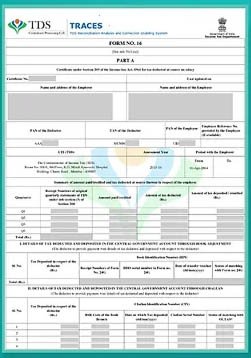TDS Return Filing
In India, tax on income, dividends, and asset sales is collected by requiring the payer to deduct the applicable tax before making the payment to the recipient. This system, known as Tax Deducted at Source (TDS), is mandated under the Income Tax Act of 1961.
TDS was introduced to ensure timely and consistent collection of taxes from various income sources. Under this system, the person responsible for making a specified payment to another person (the payee) must deduct tax at the time of payment and deposit it with the Central Government. The payee, in turn, is entitled to claim credit for the tax deducted when filing their income tax return.

Who can file TDS returns?
TDS returns are filed by employers or organizations that have a valid Tax Deduction and Collection Account Number (TAN). Any person or entity responsible for making certain specified payments is required to deduct tax at the source and deposit it with the government within the prescribed time limits.The types of payments subject to TDS, as listed under the Income Tax Act, include:
Salary payments
Income from securities
Winnings from lotteries, crossword puzzles, and similar games
Winnings from horse races
Insurance commission payments
Payments related to the National Savings Scheme
And several other specified payments
Form 24Q - Statement for TDS from Salaries:
When an employer pays salary to an employee, TDS is deducted under Section 192 of the Income Tax Act, 1961. To report this deduction, the employer is required to file Form 24Q every quarter.Form 24Q is a quarterly statement that provides details of:
Salaries paid to employees
The TDS deducted on those salaries
In simple terms, Form 24Q is a quarterly summary submitted by the employer (deductor) that reflects the salary payments made and the corresponding TDS deductions.
Form 26Q -- Quarterly statement of TDS in respect of all payments other than "Salaries":
When a taxpayer makes payments that are subject to TDS, and those payments are not related to salaries, the details must be reported using Form 26Q. This form captures information such as the total amount paid during the specific quarter and the corresponding TDS deducted on those payments. It must be filed every three months and applies to various non-salary transactions like interest, professional fees, rent, and commission where tax is deducted at source.
Form 27Q -- Quarterly statement of TDS from interest, dividend, or any other sum payments to non-residents:
Form 27Q is a TDS return used to report tax deducted at source on payments made to non-resident Indians (NRIs) and foreign entities, excluding salary payments. It must be filed quarterly, on or before the due date prescribed by the Income Tax Department. This form contains details of the payments made to non-residents and the TDS deducted by the payer on those transactions.
What is a TDS Certificate?
Form 27EQ contains all the details related to tax collected at source (TCS). It is required to be filed quarterly under Section 206C of the Income Tax Act, 1961. This form must be submitted by both corporate and government entities that collect or deduct tax at the source.
Form 27EQ -- Quarterly statement of collection of tax at source:
After TDS has been deducted, it is essential for the deductor to issue a TDS certificate to the deductee. This certificate, which can be downloaded from the TRACES portal, includes a 7-digit unique certificate number and carries the TRACES watermark, allowing the deductee to verify the tax credit.
The deductee must retain these TDS certificates for their records. For salary income, the certificate (Form 16) is issued annually, while for non-salary payments (Form 16A), certificates are provided on a quarterly basis.
If the original TDS certificate is lost, the deductee can request a duplicate copy from the deductor.
Penalty for failure in filing the TDS returns:
The assessee is subject to a penalty of Rs. 200 per day under Section 234 E if they fail to submit their TDS returns by the deadline for as long as the failure lasts.
Non Filing the TDS returns:
The assessee will also be responsible for paying a penalty if they failed to file their return within a year of the due date or if they provided inaccurate information. The fine imposed ranges between Rs. 10,000 and Rs. 1,00,000.
Revised TDS Returns:
If errors are identified after the TDS returns have been filed—such as incorrect challan details, missing PAN information, or an incorrect PAN—the tax amount credited to the government will not reflect correctly in Form 16A or Form 26AS. To correct these discrepancies and ensure that the tax credit is properly recorded and visible in Forms 16, 16A, and 26AS, a revised TDS return must be submitted.
Prerequisites for submission of Revised TDS returns:
Revised TDS returns can only be filed after the original TDS return has been accepted by the TIN central system. The assessee can check the status of the original return through the TIN Central System. By providing details such as the PAN and the Provisional Receipt Number (PRN) or Token Number on the NSDL website, the assessee can track the status of the filed TDS returns.
To prepare the revised TDS return, the most recent consolidated TDS statement must be used. This consolidated file can be downloaded from the TRACES portal.
Documents Required For TDS Return Filing:
- TDS Acknowledgement
- PAN card details of the individual.
- TDS Certificate, If the TDS has been deducted by other.
- Tax Payment Challan
- Self-assessment & advance tax, if one have deposited.
- Bank Statement, All details of the individual’s bank account.
